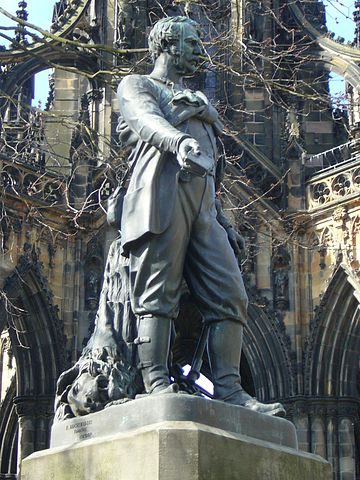
File:David Livingstone statue, Princes Street Gardens, Edinburgh.jpg

Size of this preview: 360 × 480 pixels.
| |
This is a file from the Wikimedia Commons. Information from its description page there is shown below.
Commons is a freely licensed media file repository. You can help. |
Summary
| Description |
English: Statue commemorating the Congregationalist missionary, explorer of Africa and enemy of slavery who became a popular hero of late-Victorian Britain. The statue was proposed in 1874, a year after reports arrived of Livingstone's death in Zambia. He shares the plinth with the lion he shot in Mabotsa. Savaged by the enraged animal before it was brought down by a spear, Livingstone lost the effective use of his left arm which was crushed; but his right arm retains the power to extend the Bible. The architecture behind belongs to the Scott Monument.
|
| Date | 26 March 2010 |
| Source | Own work |
| Author | Kim Traynor |
Licensing
|
File usage
The following pages on Schools Wikipedia link to this image (list may be incomplete):
Metadata
This file contains additional information, probably added from the digital camera or scanner used to create or digitize it. If the file has been modified from its original state, some details may not fully reflect the modified file.
| Camera manufacturer | Panasonic |
|---|---|
| Camera model | DMC-LS2 |
| Exposure time | 1/100 sec (0.01) |
| F-number | f/4.5 |
| ISO speed rating | 100 |
| Date and time of data generation | 23:48, 26 March 2010 |
| Lens focal length | 14.3 mm |
| Orientation | Normal |
| Horizontal resolution | 72 dpi |
| Vertical resolution | 72 dpi |
| Software used | Ver.1.0 |
| File change date and time | 23:48, 26 March 2010 |
| Y and C positioning | Co-sited |
| Exposure Program | Normal program |
| Exif version | 2.2 |
| Date and time of digitizing | 23:48, 26 March 2010 |
| Meaning of each component |
|
| Image compression mode | 4 |
| Exposure bias | 0 |
| Maximum land aperture | 3 APEX (f/2.83) |
| Metering mode | Pattern |
| Light source | Unknown |
| Flash | Flash did not fire, compulsory flash suppression |
| Supported Flashpix version | 0,100 |
| Colour space | sRGB |
| Sensing method | One-chip colour area sensor |
| File source | Digital still camera |
| Scene type | A directly photographed image |
| Custom image processing | Normal process |
| Exposure mode | Auto exposure |
| White balance | Auto white balance |
| Digital zoom ratio | 0 |
| Focal length in 35 mm film | 107 mm |
| Scene capture type | Standard |
| Scene control | None |
| Contrast | Normal |
| Saturation | Normal |
| Sharpness | Normal |
Schools Wikipedia facts
Wikipedia for Schools was collected by SOS Children's Villages. SOS Children's Villages works in 133 countries and territories across the globe, helps more than 62,000 children, and reaches over 2 million people in total. If you'd like to help, learn how to sponsor a child.
